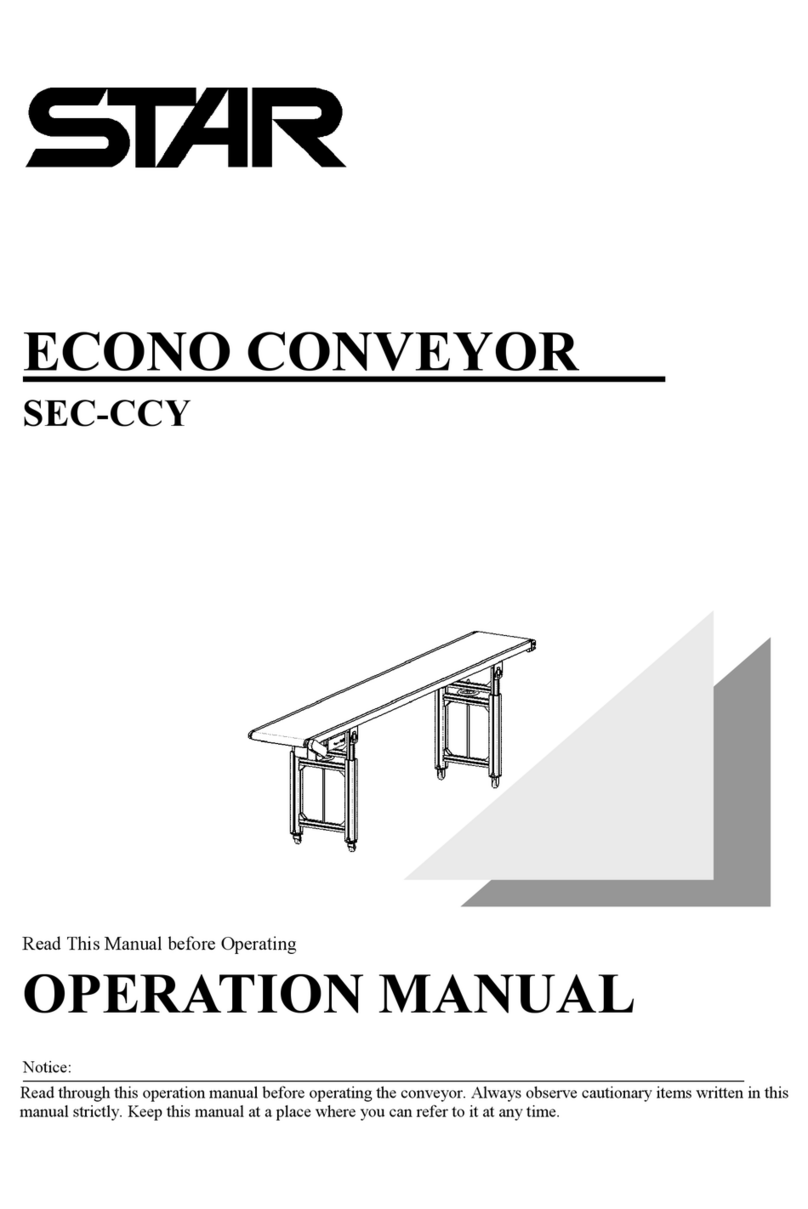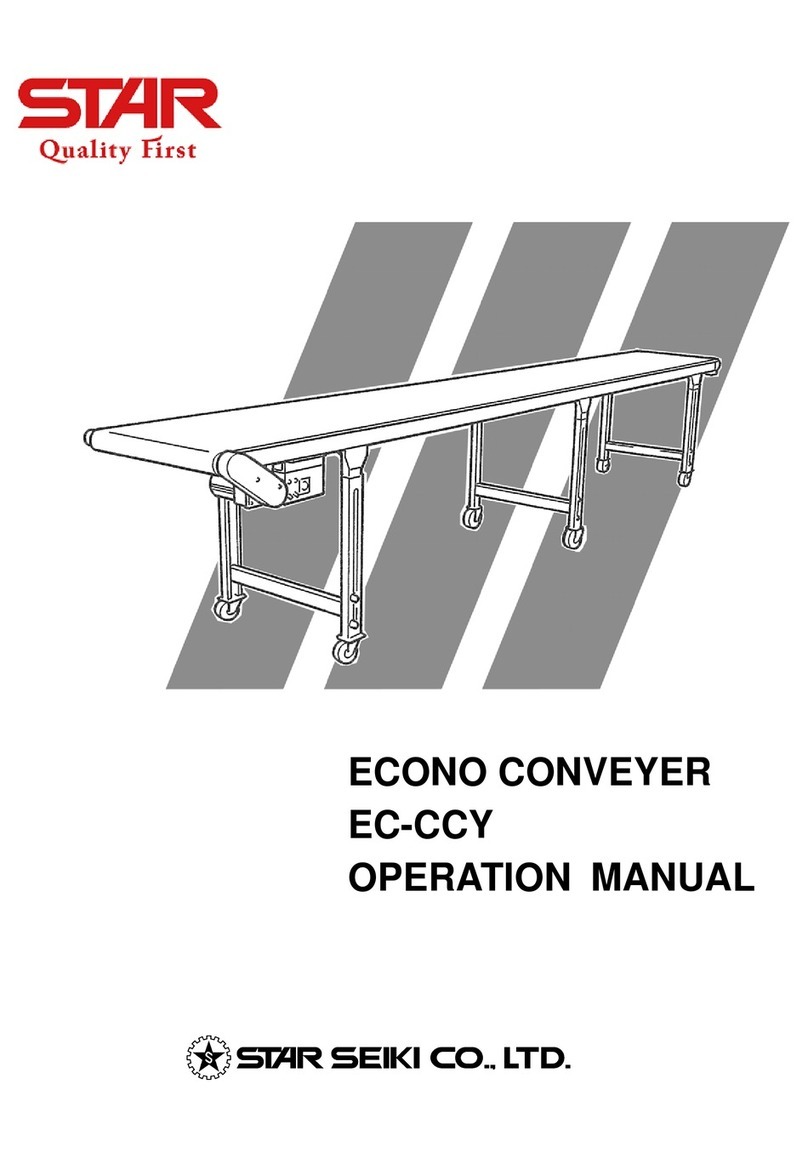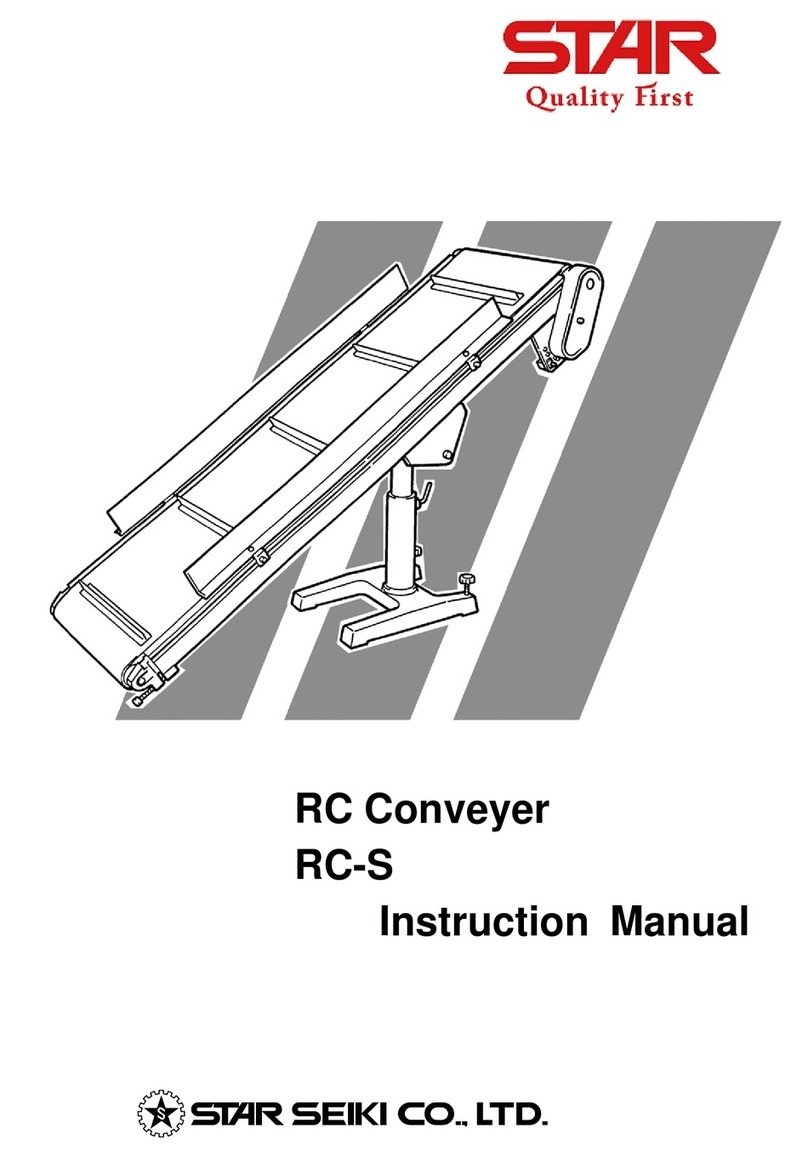Star PC-CCY User manual

Pool Conveyer
PC-CCY
Instruction Manual

INTRODUCTION
INTRODUCTION
Thank you for purchase of the Star Conveyer “Pool Conveyer”. This manual describes the
machine's functions and presents important information about operating methods and
precautions. Please read through this manual carefully so that you will be able to use the
machine safely and effectively. Keep this manual in a place of easy access.
Feature
● Best-suited for medium-size and large-size injection molding machines and for long-time
stocking.
● Regular maintenance is not almost required with the geared motor and the chain.
● Interlock operation with devices such as an unloader with external signals allows intermittent
operation of the conveyor. And the movement dimension of the product can be changed easily.
● The conveyor can be used not only for conveyance and stocking but for a simple workspace.
● Using synthetic-resin belt reduces surface flaws and stains on the product. And it has high heat
and oil resistance.Also it prevents electrostatic buildup. So the conveyor is suitable for plastic
molding.

CONTENTS
CONTENTS
1. PRECAUTIONS
1-1. Warranty ··························································································· 1
1-2. Handling precautions················································································ 1
1-3. Specifications ······················································································· 2
2. PARTS AND FUNCTIONS
2-1. Overview ··························································································· 3
2-2. Control box (Control panel) ······································································ 5
3. MECHANICALADJUSTMENTS
●Adjusting the height ················································································· 6
●Adjusting the belt tension ··········································································· 6
●After making the adjustments ······································································ 7
●Maintenance ··························································································· 7
4. PARTS LIST ······················································································ 8
5. ELECTRICAL CIRCUIT DIAGRAM ··············································· 9
6. OVERVIEW ························································································ 11

-1-
1. SAFET
Y
-RELATED INFORMATION
1. SAFETY-RELATED INFORMATION
1-1. Safety-Precaution Indications
■Danger Level Symbols
The safety precautions in this manual are classified into the following three levels.
DANGER Failure to follow this safety precaution may result in great
physical danger to the operator, or even death.
WARNING Failure to follow this safety precaution may result in great
physical danger to the operator, or severe damage to the
equipment.
CAUTION Failure to follow this safety precaution may result in injury
to the operator, or damage to the equipment.
■About Important Points
Important points on handling are indicated with in the manual.

-2-
1. SAFET
Y
-RELATED INFORMATION
1-2. Safety Precautions
DANGER
PROHIBITING WORKER TO RIDE ON CONVEYER
Never attempt to ride on the conveyer. If the worker rides on the conveyer, it may cause
the risk of making the conveyer unstable and so fall down, getting the worker injured.
DO NOT PERFORM MAINTENANCE WHILE CONVEYER
IS RUNNING!
Never attempt to service or perform maintenance on the conveyer while it is running.
Before carrying out maintenance, be sure to shut down the machinery as follows: (1) Shut
down the air supply. (2) Switch off the POWER switch in the control box. (3) Cut the
power breaker.
WARNING
Wear appropriate work clothes.
Do not wear bulky clothing and accessories when working at the conveyer, as these may
be caught in the machinery, getting the worker seriously injured.
Do not attempt to modify the conveyer.
Do not redesign, rebuild, or otherwise modify the conveyer. The manufacturer cannot be
responsible for accidents or damage caused by modified equipment.
Be sure to ground the conveyer.
Use a No.3 ground setup to help reduce the risk of electric shock at installation. Also,
after moving the conveyer to another place or performing periodic inspection, make sure
that the specified ground setup has been done.

-3-
1. SAFET
Y
-RELATED INFORMATION
Use a non-fuse circuit breaker.
To avoid the risk of fire due to overcurrent, include a non-fuse circuit breaker in the
wiring leading to the power source.
Do not open the cover on the power box.
High voltages are present within the power box. Opening the cover may lead to serious
electric shock.
Do not remove the chain cover for operation.
Operating the conveyer with the chain cover removed may cause the risk of getting the
worker caught or pinched in the machinery.
Do not touch the conveyer belt while it is running.
Never put your hands inside the conveyer belt while it is moving. Doing so may cause the
risk of getting your hands caught or pinched in the conveyer driving rollers.
Shut down operation during periods of frequent power outage.
The machinery should be shut down during times when power supply is frequently going
off due to thunderstorm or other such external event. Operating with an irregular power
supply may lead to equipment damage. If you cannot locate the cause of failure, please
contact the engineering service personnel of our sales office.
CAUTION
Confirm mutual safety in the case of cooperated work.
When two or more persons jointly work together, be sure to clarify who is responsible and
confirm safety by pointing the finger to all safety confirmation places and saying “O.K” if
safe before getting operation started, in order to avoid accidents due to miss-operation or
safety confirmation failure at manual adjustment.

-4-
1. SAFET
Y
-RELATED INFORMATION
Secure adequate maintenance space.
For safe operation, please leave at least 1 meter of maintenance space (with empty floor)
around the circumference of the conveyer.
Work under bright illumination.
To ensure that work is done safety in setting the conveyer and performing service or
maintenance, be sure to work under bright illumination.
Carry out daily maintenance inspections.
Check machinery daily to make sure it is in safe operating condition. Contact STAR
SEIKI in the event of problem.
Stop working in the event of breakdown or other problems.
If you think that the conveyer is abnormal or malfunctioned, do not keep working based
on your own thought. Simply stop operating it. Be sure to get operation started on the
basis of appropriated instructions from our engineering service personnel.
Never touch the switches with wet or dirty hands.
Doing so may cause the risk of not only getting the conveyer malfunctioned but also
accidents due to electric shock.
Stop all devices linked to the conveyer during operation.
Before carrying out inspection, repair, adjustment, cleaning or lubrication work in the
conveyer’s moving range, be sure to shut down not only the conveyer itself but also all
devices linked to is, such as your molding machine, etc. A failure to do this may cause the
risk of getting the worker seriously injured due to unexpected drive.

-5-
1. SAFET
Y
-RELATED INFORMATION
■Kinds of Caution Plates
* Note that some of the caution plates given below are not used on the conveyer.
Caution for high voltage electrical shock
Make sure to cut off the breaker of
controller while maintenance work is
being done. Especially during such work
for inside the box, disconnect connecting
cable with molding machine and cut off
primary power supply of the factory.
This label can be found at the locations
(terminal block, etc.) where special
attention is required in the range of high
voltage warning.
Caution for danger of enfolding
To work in moving zone for maintenance
or other purposes, do not touch carelessly
with such parts as motor, rotary axis, gear,
pulley, belt which have danger of
enfolding you. Cut off power supply and
air pressure to work.

-6-
1. SAFET
Y
-RELATED INFORMATION
● Caution for static electricity
The conveyor belt or the product on
the conveyor may be charged by static
electricity. You may be shocked by
electric when approaching.
CAUTION
The conveyor belt
may be charged by
static electricity.

-7-
1. SAFET
Y
-RELATED INFORMATION
1-3. Caution plates
The following diagram shows the location and content of caution plates affixed to the conveyer.
■Example of caution plates disposition
CAUTION
The conveyor belt
may be charged by
static electricity.

-8-
1. SAFET
Y
-RELATED INFORMATION
1-4. Specifications
Model
PC****-* CCY
Control box CC-4BⅢtype
Belt width 3…300 mm
4…400 mm
5…500 mm
Overall length 4000…4000 mm
5000…5000 mm
Height m/m 900~1300 Free adjustment
Power consumption AC200V 60W(90W)
Speed 1~4 m/min (60HZ)
Maximum transport weight
(horizontal position)[kg] 70
Overall weight [kg] See accompanying table.
Optional specifications 1002-02 feet + variable speed specifications
(1~8 m/min 60HZ)
●Overall weight (Kg)
Belt width
Overall length 3CCY 4CCY 5CCY 6CCY 7CCY 8CCY 9CCY 10CCY
PC4000- 108 114 120 126 132 138 144 150
PC5000- 128 134 140 146 152 158 164 170
PC6000- 148 154 160 166 172 178 184 190

-9-
2. PARTS AND FUNCTIONS
2. PARTS AND FUNCTIONS
2-1. Overview
①Conveyer belt
This belt is made from synthetic resin which offers static-electricity prevention and oil/heat
resistance.
②Control box
Controls the conveyer drive status.
③Caster
Use these casters to move the conveyer belt. Lock each caster using the stopper after
installation.
④Tension adjustment bolt
Use this bolt to adjust the loosened conveyer belt. After adjustment, tighten the bolt securely.
* Do not adjust the belt too tightly.
* Adjust both bolts equally.
⑤Height adjustment handle
Loosen this handle to adjust the height of the conveyer stand. Be sure to lock this handle after
adjustment.
Loading side
Unloading side
④
②
③
⑤
①

-10-
2. PARTS AND FUNCTIONS
⑥Motor gear reduction unit
This is the drive source of the conveyer, with a speed of 1 to 4 m/min (60HZ) [standard type].
* You can reverse the conveyer transport direction by switching the motor wiring. Consult
the nearest Star office before you switch the wiring.
⑦Chain cover
Remove this cover to adjust and check the chain sprocket.
Unloading side
⑦
⑥

-11-
2. PARTS AND FUNCTIONS
2-2. Control Box (Operation Panel)
■Standard type(CC-4BⅢ)
1.Power Switch
Turn on/off the power of conveyor
2.Speed Setting Switch
This switch is used to set the speed of product delivery.
Setting range: 1~3m/min
Note: this speed is measured at a frequency of 60Hz.
3.Power LED
This LED is on when turning on the power.
4.Working LED
The green LED is on when conveyor works normally. The green LED flashes when alarming.
5.Mode LED
This LED is on when conveyor works in interval mode.
6.Mode Selecting Switch
This switch is used to shift modes (Press)
・INTERVAL……………Conveyor start signal is input from an Unloader. Conveyor works in
the setting time of timer.
・CONTINUATION………The conveyor works continuously.
Product Delivery Timer (Rotate)
After pressing switch No.6 and select interval mode, please rotate the switch No.6 to set
the time interval for the conveyor to deliver products.
Use this knob to set the product feed speed.
Conveyor speed specified range: 0.25 to 3 m/min (1 to 3 Recommended)
Note : The speed is for 60 Hz.

-12-
3. MECHANICALADJUSTMENTS
3. MECHANICAL ADJUSTMENTS
After the location of the unit is decided, lock the casters and perform the following adjustments:
●Adjusting the height
Use the hexagonal wrench to loosen the height
adjustment bolts located on the stand legs near the
casters (2 bolts × 4 positions), and adjust the height of
the conveyer belt.
* After adjustment, tighten the handles securely.
●Adjusting the belt tension
Loosen the fixing bolt on each side of the unloading
end, and adjust the belt tension using the tension
adjustment bolt.
* Do not adjust the belt too tightly.
* Adjust both bolts equally.
* Tighten the fixing bolt securely after adjustment.
Adjust the belt tension only when the conveyer belt
weaves or when the conveyer driving roller is rotating
without transporting the belt. Otherwise, you do not
need to adjust the belt tension.
Fixing bolt
Tension adjustment bolt
Lock Release
Loosen
Tighten
Lock
Release

-13-
3. MECHANICALADJUSTMENTS
●After making the adjustments………
①Wire the power and conveyer start signal.
* Shut off the power on the supply side (primary side) during the wiring operation.
* Refer to the instruction manual that came with the control box of the unloading machine for the
wiring of the conveyer start signal (SG1, SG2).
Consult the nearest Star office before you try to input the conveyer start signal from a machine
other than a Star unloading machine.
②Insert the metal connectors to the rear panel of the control box.
* Shut off the power on the supply side (primary side) when removing/inserting the metal
connectors.
●Maintenance
Remove the chain cover to apply grease to the chain
once every six months.
* Install the chain cover after applying grease.

-14-
4. PARTS LIST
4. PARTS LIST
Name Type
Manufacturing Qty Code No.
Motor
(See accompanying table.)
M91Z60GV4Y Panasonic 1 122733
M91Z90GV4Y Panasonic 1 122735
Gear head MY9G100B Panasonic 1 122684
Gear head
(0P 1~8m/min 60HZ) MY9G50B Panasonic 1 122692
Conveyer belt SL-F1502 ****-*** BANDO 1
●Motor capacity
Belt width
Overall length 3CCY 4CCY 5CCY 6CCY 7CCY 8CCY 9CCY 10CCY
PC4000- 60W 60W 60W 60W 60W 90W 90W 90W
PC4500- 60W 60W 60W 60W 60W 90W 90W 90W
PC5000- 60W 60W 60W 60W 90W 90W 90W 90W
PC5500- 60W 60W 60W 60W 90W 90W 90W 90W
PC6000- 60W 60W 60W 90W 90W 90W 90W 90W

-15-
5. WARRANTY AND AFTER-SALE SERVICE
5. WARRANTY AND AFTER-SALE SERVICE
For information about repairs and other service, refer to the nearest STAR SEIKI business
office.
■Warranty
1. The term of the warranty specified by the contact shall begin upon purchaser’s approval of
the delivered machine. In principle, the term of warranty shall be six (6) months.
2. Breakdowns that occur within the term of warranty period shall be repaired free of charge,
with the exceptions noted immediately below.
3. The following are not covered by the warranty.
・Breakdown caused by inadequate maintenance or inspection.
・Damage caused by improper handling of the machine.
・Damage caused by fire or natural disaster (act of God).
・Damage related to expendable components (chucking parts, etc.)
・Damage caused by modification or attempted repair carried out by user. (Refer to Section
1-5 for machine specifications.)

-16-
6. ELECTRIC CIRCUIT DIAGRAM
6. ELECTRIC CIRCUIT DIAGRAM
●Econo Conveyer Electric Circuit Diagram (Standard Specifications)
AC200V specifications
※1. Usage method of SW terminal
Under Intermittent action mode, if want to control the conveyor manually, please use SW terminal.
Please use B connection switch.
※
2 Temperature fuse input terminal
SEC conveyor can not use.
※
3 Time selection
S1-2:OFF According to the setting time of Interval Time(VR1)to perform the action.(Standard
Mode)
S1-2:ON Interval Time(VR1)is invalid, SG1 2 is ON, execute the action.
Unloader need to control the time of the action, please use S1-2 ON
※
4 The capacity of TB3 capacitor(The accessory of the Motor)
100V : 12uF/250V
115V : 10uF/250V
200V : 3uF/450V
220/230V : 2.5uF/450V
※
5 If use 90W (Or above 90W) type of motor, need to connect the fan.
The supply voltage of the fan is the same as the output voltage of the conveyer。
※
6 The input voltage of the Board is AC100V or AC200V. Do not need power supply shift switch。
Due to the different voltage, the connection of the motor, TB3 capacitor etc. are also different.
Please pay attention to it.
※1 External switch OPEN: Permanent action
External switch Close: Intermittent action
Rotation direction shift terminal
(COM,CW,CCW)
SEC conveyor can not use
Please do not alter the COM Jumper

-17-
6. OVERVIEW
7. OVERVIEW
Table of contents
Other Star Accessories manuals




















